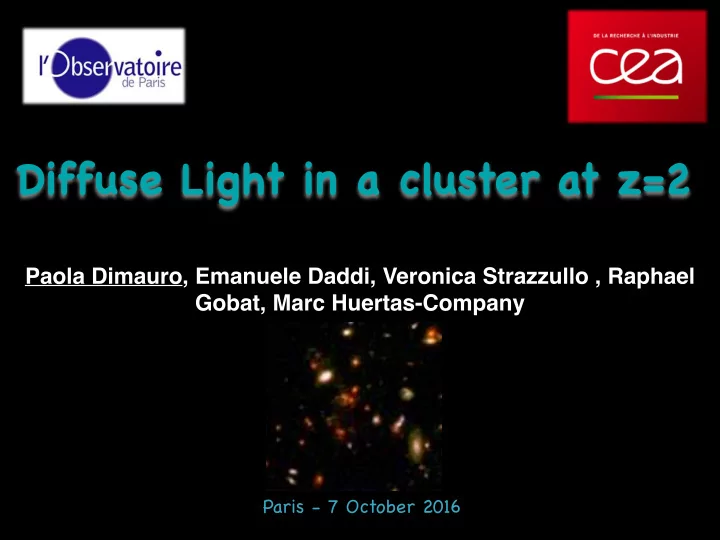

Diffuse Light in a cluster at z=2 Paola Dimauro, Emanuele Daddi, Veronica Strazzullo , Raphael Gobat, Marc Huertas-Company Paris - 7 October 2016
What is the diffuse light? Stars stripped from the outer region of the galaxies during the cluster’s formation Coma cluster The properties of the ICL in clusters, particularly the fractional luminosity, radial light profile, and presence of substructure, may hold important clues about the accretion history and dynamical evolution of galaxy clusters.
What is the Intra-Cluster Light ( ICL ) Formation mechanism: � Density � � � • Shredding of dwarf galaxies • Stripping process : high • Tidal stripping mass clusters have more ICL • In situ star formation then low ones • Merging � • Merging : no correlation with the mass De Maio 2014,Krick 2007
Diffuse light When? -> Color � � Formation mechanism: � • Red : Stars are stripped early � and then evolve passively • Shredding of dwarf galaxies towards red color � • Tidal stripping � • In situ star formation • Same color of the galaxies : • Merging remnant from ongoing interaction � • Blue : recent star formation activity has made De Maio 2014,Krick 2007
Diffuse light Formation mechanism: � When? -> Spatial distribution � � � • Shredding of dwarf galaxies the morphology of the ICL • Tidal stripping changes as the cluster evolve: • In situ star formation at the beginning is • Merging characterized by tidal features then they tend to mix to form a more diffuse halo. De Maio 2014,Krick 2007
From the letterature … • 0.8 < z < 1.2 diffuse light : 1-4% (Burke et all 2012) • Krick & Bernstein 2007 z < 0.4 diffuse light fraction : 6-22 % (Krick 2007)
From the letterature … • ICL amount increase as cluster evolves ~ 10-15 % at z=0 f_icl time time time simulation (Rudick 2006) merger • Semi-analitic model z<=1 : ICL vary between 5-25 % (Contini 2014) • The formation of the ICL has no preferred redshift and is a cumulative power-law process up to redshift z = 0. (Murante et all 2007)
Goal of this work CL J1449+0856 M tot ' 6 ⇤ 10 13 M � z = 1 . 99 Instrument: HST WFC3 Bands: F105, F140
First step : Optimal background removing What is new? Remove contamination / gradient from bright sources • � Preserve the diffuse halo of low surface brightness : ICL • The solution Dynamical masking to cover wide range of size
First step : Optimal background removing Mask Background map The background map is estimated using Sextractor. In the masked region is interpolated from the neighboring region
First step : Optimal background removing The gradient are removed Filter : F140 Before After but the halo are preserved
Second step : Fit the models Filter : F140 The models are done using Galfit (Peng et al 2010)
Second step : Fit the models Sersic profile Σ ( r ) = Σ e [ − k ( r 1 ) n − 1] r e Ferrer profile Σ ( r ) = Σ 0 (1 − [ r ] 2 − β ) α r out
Third step : Diffuse light, model and result Filter : F140 Galfit model Residual map
Third step : Diffuse light, model and result Original image ICL ICL model Filter : F140 mag = 24 . 00 F105 : mag = 23 . 00 F140 :
Test … Is it a O III emission associated to the Lya nebula ? Filter : F140 mag = 23 . 00 mag = 25 . 9 Valentino 2016
Results : z~0.49 Instrument: Large Binocular Telescope Bands: r,g mag = 20 . 52 g-band : mag = 18 . 94 r-band : Dimauro,Giallongo in prep
Results : Color z = 0.49 z = 1.99 Preliminary results
Results : Color Red: Stars are stripped early and then evolve passively towards red color Same color of the galaxies : ICL remnant from ongoing interaction Blue : recent star formation activity has made Krick 2006
Results : Absolute magnitude Preliminary results
Results : Absolute magnitude - 0 . 5 Z � Z � - � 2 Z � - - - BC03 _. MC05 Preliminary results
Results : Mass ratio M ⇤ ' 0 . 5 � 1 ⇤ 10 12 M � M ICL ' 3 � 5 ⇤ 10 10 M � M ICL 3- 10 % ' M ∗ Higher than what is predicted by the simulation Preliminary results
Conclusion Measure the diffuse light in a cluster at z~2 : � • The color is more blu than the red sequence � • is brighter than the diffuse light found in cluster at low-z � • the mass fraction is 3-10 % higher then what is predicted by the simulation � Our result is in agreement on what is found in other clusters The fraction of diffuse light increase with the redshift and it depend on the mass assembly story of the cluster and on the different proper.
Conclusion • Absolute magnitude : brighter than low z � • Mass ratio : almost the same � • Color : bluer than the red-sequence of the cluster at z~1.99
from the letterature … mag=26.2 Zanella 2015
F105
F105
Recommend
More recommend